Services on Demand
Article
Indicators
Related links
-
 Cited by Google
Cited by Google -
 Similars in Google
Similars in Google
Share
Journal of the South African Institution of Civil Engineering
On-line version ISSN 2309-8775
Print version ISSN 1021-2019
J. S. Afr. Inst. Civ. Eng. vol.52 n.2 Midrand Oct. 2010
TECHNICAL PAPER
Evaluation of recycled water recovered from a ready-mix concrete plant for reuse in concrete
S O Ekolu; A Dawneerangen
ABSTRACT
A study was conducted into the quality of recycled water at a ready-mix concrete plant to determine its suitability as mixing water for concrete. Concrete mixes made at a water/cementitious ratio (w/cm) of 0,5, with or without 50% ground granulated blast-furnace slag, and mortars of 0,47 w/cm were prepared using municipal and recycled water. Recycled water was used to replace municipal water at various proportions of 0, 30, 50 and 100%, then used as mix water. Tests were done on fresh and hardened concretes and mortars. The chemical impurities present in the recycled water satisfied the limits given in SANS 51008 /EN 1008 and ASTM C 94 for mix water. The use of recycled water as mix water led to a slight reduction in slump of concrete or flow of mortar. Hydration heat output and air permeability were not affected, and mortar compressive strengths increased with a rise in the proportional amount of recycled water used in the mix. In mortars, the use of 100% recycled water gave a substantial increase in strengths of up to 8%. Within the limitations of this study, it was found that recycled water from ready-mix concrete plants can be suitable for use as mix water in concrete-making.
Keywords: recycled water, ready-mix concrete, compressive strength, setting time, slump, flow, permeability, mortar
INTRODUCTION
Significance of recycling waste wash water from ready-mix concrete operations
Waste water from a ready-mix plant consists of wash water from rinsing out truck mixers, storm water run-off, sprayed water from rinsing the exterior drums and sprayed water from dust suspensions. It is estimated that a truck uses approximately 500 litres of water per washout. Typically, a truck mixer washout takes place twice daily and if there are 15 trucks per day, this amounts to the use of 15 000 litres of wash water per day. Obviously, it can be seen that when this consumption is combined with storm water run-off, sprayed water and conveyor water washdowns, significantly large quantities of waste water are generated at a typical ready-mix plant in any given working day. Also, a typical ready-mix plant may produce 500 m3 of concrete per day. On the basis of 200 litres/m3 of concrete, the plant consumes 10 000 litres of municipal water per day. This water quantity is sufficient to supply water to over 200 African households daily. Certainly, the industrial consumption of municipal water may exert remarkable strain on the water supply network, especially in Africa where water shortages are apparent, with some communities lacking adequate water supplies.
Environmental pressures have also mounted regarding the disposal of waste water as regulations have been crafted to control water quality and provide environmental health protection. Past practices have been to dispose of waste water either at construction sites, landfills, vacant plots, plant yards or almost any location provided the disposal raised no public concern. However, wash water discharge from truck washing contains cementitious materials and other impurities. According to the South African National Water Act (NWA 1998), such water may not be discharged into urban sewers due to its high content of dissolved solids and its high pH. The National Water Authority does allow the discharge of effluent, provided that the water quality of such effluent meets the requirements of the Act. The practice of recycling waste water has therefore become essential, both as a means of water conservation and as a necessary process for a safe environment. When reused in concrete, wash waste water can also make an economic contribution as its reuse does not necessitate chemical treatment.
Wash waste water from ready-mix concrete as mix water for concrete
Studies have been done on the potential use of waste water in concrete, but although important conclusions have been reached, some mixed results have also been reported. Abrams (1924) conducted an extensive series of tests consisting of about 6 000 concrete and mortar specimens representing 68 water samples. He found that any naturally occurring or municipal water supply suitable for drinking purposes can be used as mix water for concrete. Although no wash waste water was used in this early study, a significant finding was that different types of water containing impurities such as marsh water, alkaline sulphate water and industrial waste water were satisfactory when tested in mortars or concretes since in many instances, the strength would be greater than 90% of the strength of control specimens made using pure water. However, algae in the mixing water were found to entrain air and reduce concrete strength significantly.
Borger et al (1994) examined the strength, setting time, workability and sulphate resistance of mortars incorporating recycled wash water. Mortars with a water/cement ratio (w/c) of 0,485 and 1:2,75 aggregate-cement ratio were used. It was reported that the age of the wash water had the greatest effect on strength, with an increase of up to 20%. An increase in strength was generally realised when water of ages up to 8 h were used in mortars, while workability and permeability were reduced. Sulphate resistance was also reported to have increased. These effects were attributed to the increased cement content of mortars from suspended cement particles present in the wash water. A study by Selih et al (2003) done on recycled water produced at three Slovenic batching plants using 30 MPa concrete of 0,4 w/c made with CEM I 42.5R cement also attributed the slump and air content reduction observed to an increased level of fine particles. Unlike the findings of Borger et al (1994), Selih et al (2003) reported a 10% loss in strength as a result of using recycled water but also indicated improved water tightness. Sandrolini and Franzoni (2001) also investigated the use of waste wash water from a medium-sized ready-mix concrete plant for use as mix water, and showed that the 28-day compressive strengths of mixes containing wash water were at least 96% of those of the control mix. The concrete mix used had a w/c of 0,57 with CEM II/A-L 42.5R cement. Reduction in water absorption and porosity was also reported, indicating potential improvement of durability due to the use of the wash water.
Depending on the water source or impurities present, some recycled water may not be suitable for use in concretes. Such findings were reported by Kuosa (2005) in a study of five types of water containing detergents. The recycled water, used in proportions of 26 to 100% of mix water, had no effect on the setting time and strength of concretes. However, its use adversely affected the air-void structure and spacing factor, rendering its effect in air-entrained concrete a potential issue of durability concern regarding freeze-thaw resistance.
Potential use of sludge water as mix water in concrete has also been investigated with mixed results. Concretes with w/c's of 0,5, 0,6 and 0,7 were studied by Chaatveera et al (2006) for unit weight, slump, temperature rise and mechanical properties of compressive strength, modulus of elasticity, as well as drying shrinkage and acid attack. Although the unit weight and temperature of fresh concrete were not affected by the use of sludge water, slump and strength decreased. Increasing the proportion of sludge water in the mix water also increased drying shrinkage and weight loss due to acid attack.
Assessing the suitability of recycled water for use in concrete
The traditional criterion widely employed to define the suitability of mix water has been to compare its quality with fitness for drinking. However, specifications have been developed giving limits of acceptable chemical impurities and their effects on certain concrete properties. These major criteria are given in SANS 51008 and ASTM C 94 in which the 7-day or 28-day compressive strength of concretes or mortars incorporating recycled water must achieve at least 90% of the strength of control samples made with municipal or distilled water. For mixes containing recycled water, ASTM C 94 allows deviations of 1 h and 1,5 h for the initial and final sets respectively, while SANS 51008 specifies deviations not exceeding 25% of the setting time of a control mix made with distilled water.
While use of recycled water in the ready-mix concrete industry in South Africa is practised, and encouraged in the interests of water conservation and environmental protection, there has been little or no investigation into its effects on the properties of concrete. This study examined the quality of recycled water at a ready-mix concrete plant in Gauteng to determine its suitability as mixing water for concrete. Tests done on the properties of fresh and hardened mortars and concretes include slump or flow, unit weight, setting time, total hydration heat output, compressive strength and air permeability.
EXPERIMENTAL
Materials and mixes
A 200 litre water sample was collected from the water pit at the ready-mix concrete plant and kept in a drum for laboratory use. Water stored in the drum was manually agitated before being drawn for concrete mixing. In the water pit, an agitator is used to stir the water to prevent solids from settling at the bottom. A 200 litre sample of municipal water was also collected to be used in the mixes at different replacement proportions. CEM I Portland cement complying with SAN 50197-1 and ground granulated blast furnace slag (ggbs) complying with SANS 1491-1 were the cementitious materials used. In all the mixes, 19 mm granite coarse aggregate, crushed granite sand, natural filler sand and a water-reducing admixture of type Omega 101 were used.
Recycled water was used to replace tap water at the various levels of 0, 30, 50 and 100%, then used for making mortars and concrete mixes. As shown in Table 1, a total of eight concrete mixes with w/c's of 0,5 were made. Four of the mixes contained 100% CEM I 42.5N, while the other four mixes consisted of a 50:50 CEM I/ggbs blend. Cubes of 100 mm were used to test the 7-day or 28-day compressive strengths, and cubes of 150 mm were used for air permeability measurements, which were done using a Torrent permeameter (Andrade et al 2000). Four mortar mixes with a w/c of 0,47 and an aggregate/cement ratio of 2,5 were prepared and then tested for flow using a flow table, and for compressive strength using 50 mm cubes. No ggbs was used in the mortar mixes. Concrete mix designations C0%, C30%, C50% and C100% consisted of only CEM I cement, while designations starting with "CS" contained a 50:50 CEM I/ggbs blend. Designations with "M" indicate mortar mixes. The percentage value in the designation represents the proportion of recycled water used in the mix water.
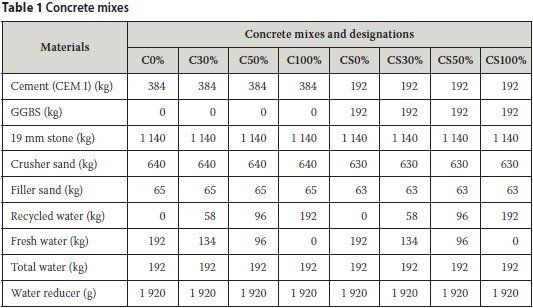
Test procedures
Tests for slump, density and strength of concrete were done in accordance with SANS 5861 and SANS 51250 respectively, while setting time evaluation was conducted on all mixes according to BS 5075-1. The compressive strengths of mortars were tested in accordance with SANS 51255, while mortar flow tests were done to ASTM C 230. Water analysis was performed using analytical instruments consisting of a Varian A10 atomic absorption spectrophotometer, a Liberty 150 ICP emission spectrometer, a PW 1400 X-ray spectrometer and a gas chromatograph. The setting time evaluation, mortar strength tests and water analyses were done as required by SANS 51008 criteria for water evaluation.
Measurement of the rate of heat evolution from hydrating cement in concrete was done by adiabatic calorimetry (Ballim & Graham 2003). It involved placement of a 1 litre sample of fresh concrete in a water bath such that a stationary air pocket separated the concrete sample from the water. The signal from the thermal probe placed in the sample was computer monitored and the water bath was automatically maintained at a constant temperature. The Torrent permeameter (Andrade et al 2000) used to assess air permeability was an apparatus which created a controlled, uni-directional flow of air from the pores into the inner chamber, while the outer chamber acted as a guard ring, thus ensuring stable conditions of measurement. The non-destructive test gave a coefficient of permeability of concrete to air.
RESULTS AND DISCUSSION
Chemical analyses of recycled water
The analyses of recycled water and municipal water are reported in Table 2, giving amounts of chemical impurities. The values obtained for recycled water satisfy the maximum limits set out in SANS 51008. The pH of the recycled water was 12,1 as compared with 7,9 for municipal water. The recycled water presumably contained highly alkaline suspended cement particles gathered from the rinsing of truck mixers, which resulted in the high pH measured. The amount of chlorides and sulphates present in both recycled and municipal water were within the required limits but the total dissolved solids (TDS) of 1 991 mg/L in recycled water was significantly higher than in municipal water which had a TDS of 107 mg/L. Although the alkalinity due to the sodium and potassium content is higher in recycled water, its sodium equivalent Na2Oe of 58 eppm is much lower than the 600 ppm that would cause concern about the alkali-silica reaction. The recycled water also contained high quantities of calcium, carbonate and bicarbonate compared with municipal water. If the analyses of recycled water are compared with the limits set out by the National Water Act of 1988 regarding discharge into municipal storm water drains, the values for pH, conductivity, carbonates, calcium and TDS are all above the required maximum limits.
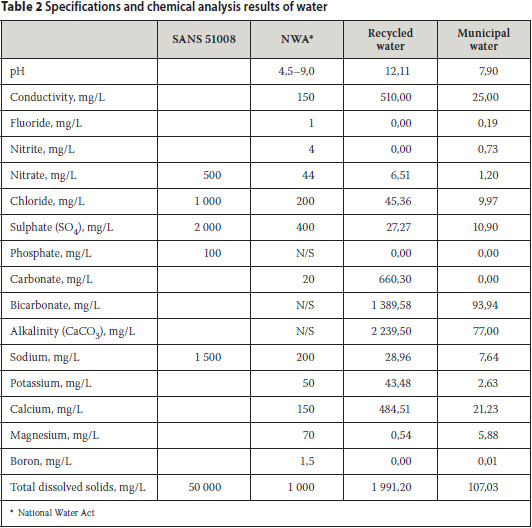
Effect of recycled water on properties of fresh concrete
The results of the slump, density, setting times, strength, permeability and heat of hydration tests conducted on the concretes are given in Tables 3 to 4, and Figures 1 to 5.
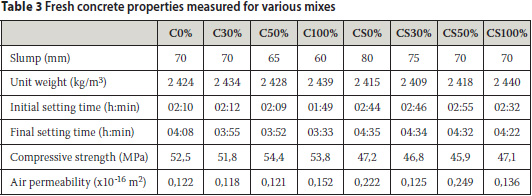


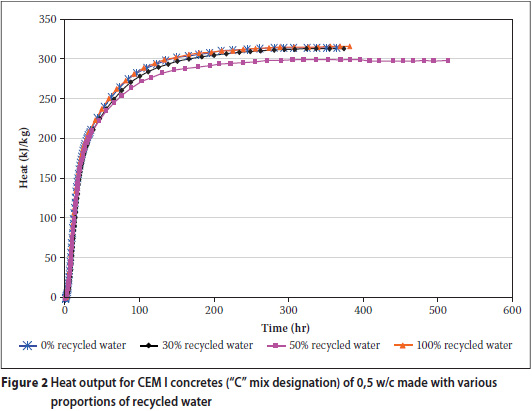
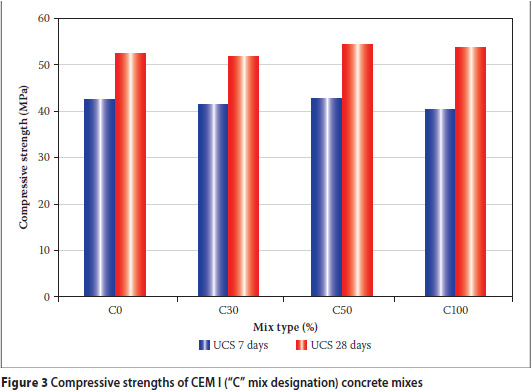
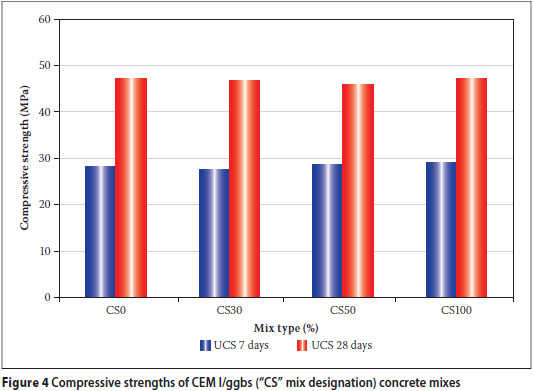
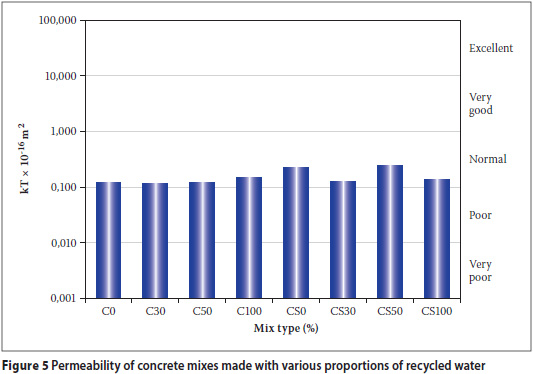
Slump and density
A trend is noticeable in Figure 1 showing that as the proportion of recycled water replacing municipal water in the mixes is increased, there is some steady corresponding decrease in slump. The recycled water contained high levels of fine particles, possibly reducing the effective w/c ratio compared with corresponding mixes of municipal water. As shown in Table 3, there was also a small but steady general increase in the density of the concrete as the proportion of recycled water used to replace municipal water was increased.
Setting times
The setting time results of the concrete mixes are reported in Table 3. The control mix, C0%, achieved an initial setting time of 2 h 10 min and a final setting time of 4 h 08 min, while mixes C30%, C50% and C100% containing recycled water all gave shorter initial and final setting times. C100% had the fastest setting time, giving initial and final setting times that were 20 and 35 min shorter than those of the control mix respectively. For mixes containing ggbs, CS0% achieved an initial setting time of 2 h 44 min and a final setting time of 4 h 35 min, which are longer setting times than those of the control mix C0%. These longer setting times of the CEM I/ggbs mixes are attributed to the presence of slag, which is known to increase the setting time of concretes for the same w/c ratio. The CS mixes also showed a relative reduction in setting times with an increase in the proportion of recycled water incorporated into the concrete mixes. Mix CS100% had the fastest setting time by 12 min for the initial set and by 13 min for the final set relative to CS0%. The reduction in setting times for mixes containing ggbs were not as pronounced as for mixes without ggbs in the binder. Analysis of these results shows compliance with the requirements of SANS 51008, as the setting times of the mixes made with recycled water are above 1 h for the initial set and below 12 h for the final set, and do not deviate by more than 25% from the setting times of their respective control mixes.
Heat output due to hydration
As shown in Figure 2, the concretes with or without recycled water showed similar properties in terms of total heat output, giving peaks of 313,2; 312,1; 296,8 and 314,8 kJ/kg for mixes C0%, C30%, C50% and C100% respectively, although mix C50% had a slightly reduced total heat output. Similarly, the maturity heat rates obtained were not found to be significantly different.
Effect of recycled water on hardened concrete properties
Compressive strength
Figures 3 and 4 show the results for compressive strength of hardened concrete for mixtures of CEM 1 and 50:50 CEM I/ggbs binders respectively. It can be seen that for concrete mixes, the difference in strengths was 2 to 3 MPa, with no particular trend associated with the proportion of recycled water in the mix. As with most other properties, small changes are usually masked in concretes due to the large volumes of aggregate they contain. In this study, compressive strengths measured with mortars were used, as required by the specifications, to get a clearer picture of the effect of using recycled water.
Air permeability
Permeability results are given in Figure 5 for mixes of CEM I and CEM I/ggbs binders. It can be seen that there is relatively less variation for mixes of CEM I binder compared with mixes of CEM I/ggbs binder. The results indicate that the blending of recycled water with tap water at various levels has an insignificant effect on permeability.
Workability and strength effects of recycled water in mortars
The results of the flow tests and 28-day compressive strengths measured for mortars are given in Table 4. It is clear that flow reduces in proportion to an increase in the quantity of recycled water used, confirming the findings showing slump reduction already discussed earlier for concretes. The 28-day strength of mortar made with 100% municipal water was 62 MPa, while mixes containing partial combinations of municipal and recycled water gave higher strengths than the control sample. The mix with 100% recycled water gave 66,5 MPa, an increase of 8% over the strength of the control. Interestingly, compressive strength monitoring of ready-mix concretes made using recycled water and used for a major project in Gauteng also has found that the use of recycled water consistently increases the strength of concrete (Attwell 2010).
CONCLUSIONS
Based on the results of this investigation, the following conclusions on the use of recycled water from ready-mix concrete plants can be made:
The recycled water was highly alkaline with a pH of 12,1 and had relatively high amounts of total dissolved solids, carbonates and calcium compared with municipal water whose pH was determined as 7,9. Treatment of the waste wash water would be required prior to its discharge into a municipal storm water system.
A trend showing some loss in workability of up to 10 mm and an increase in unit weight was observed when recycled water was used to replace municipal water partially or fully as mix water for use in concrete or mortars. Although these effects are small and may be considered negligible, they are worth noting and may be attributed to the presence of fines and cement particles in recycled water.
The setting times of concretes made with CEM I binder were more prominently reduced by the use of recycled water compared with concrete mixes incorporating slag. In plain concretes, initial and final setting times were reduced by as much as 20 and 35 min respectively when 100% recycled water was used.
An increase in compressive strength was realised as the amount of recycled water in the mixing water increased, when tested using mortars. Concrete did not show an increase in strength as found for mortars, but all the concrete mixes achieved at least 90% of the strength of the control, with some results equalling or exceeding the strength of the control mix. In mortars, an increase in strength of up to 8% due to the use of recycled water was observed.
To sum up, observations and test results indicate that recycled water may be used as mix water for concrete without having significant adverse effects on its properties.
ACKNOWLEDGEMENTS
This paper is based on the work of Amit Dawneerangen towards an MSc degree in Civil Engineering at the University of the Witwatersrand. The authors would like to thank Afrisam (Pty) Ltd (formerly Holcim) for providing the ready-mix plant site and facilities for the successful conduct of this study.
REFERENCES
Abrams, D A 1924. Tests of impure waters for mixing concrete. Proceedings, American Concrete Institute, 20: 442-486. [ Links ]
Andrade, C, Gonzalez Gasca, C & Torrent R, 2000. The suitability of the TPT to measure air permeability of cover concrete. Proceedings, 5th CANMET/ACI International Conference on Durability of Concrete, Barcelona, 4-9 June 2000. [ Links ]
Attwell, C 2010. Wash water recycling - beneficial or detrimental? Paper presented at the National Symposium on Concrete for a Sustainable Environment, Concrete Society of Southern Africa, 3-4 August 2010, Kempton Park, Johannesburg. [ Links ]
Ballim, Y & Graham, P C 2003. A maturity approach to the rate of heat evolution in concrete. Magazine of Concrete Research, 55(3): 249-256. [ Links ]
Borger, J, Carrasquillo, R L, Fowler, D W 1994. Use of recycled wash water and returned plastic concrete in the production of fresh concrete. Advanced Cement Based Materials, 1: 442-486. [ Links ]
Chatveera, B, Lertwattanaruk, P & Makul, N 2006. Effect of sludge water from ready-mix concrete plant on properties and durability of concrete. Cement and Concrete Composites, 28: 441-450. [ Links ]
Kuosa, H 2005. Recycling of concrete, sludge and water in the concrete industry, Proceedings, 18th BIBM International Congress, 11-14 May, Amsterdam. [ Links ]
NWA 1998. National Water Act, Act No 36 of 1988. http://www.actsonline.co.za [ Links ]
Sandrolini, F & Franzoni, E 2001. Waste wash water recycling in ready-mix concrete plants. Cement and Concrete Research, 31: 485-489. [ Links ]
Selih, J, Milost, E & Cuznar, A 2003. Use of recycled rubble-based aggregate and recycled water in concrete. Proceedings, International Symposium on Recycling and Reuse of Waste Materials, University of Dundee, Scotland, 9-11 September. [ Links ]
 Contact details:
Contact details:
School of Civil & Environmental Engineering University of the Witwatersrand
Private Bag 3 WITS 2050
South Africa
Tel: 27 11 717 7117 Fax: 27 11 717 7045
e-Mail: Stephen.Ekolu@wits.ac.za
Contact details:
Afrisam (South Africa) (Pty) Ltd
P O Box 6367 Weltevreden Park 1715
South Africa
Tel: 27 83 571 7991
e-Mail: amit.dawneerangen@za.afrisam.com
 | STEPHEN EKOLU is a lecturer in construction materials engineering at the University of the Witwatersrand. For six years, after obtaining his BSc, he worked in different capacities as construction site engineer in materials testing and in research. He then obtained an MSc (Eng) with distinction from the University of Leeds, UK, and a PhD from the University of Toronto, Canada. His research interests include materials science aspects of concrete, durability, waste utilisation and recycling, and sevice life of concrete structures. |
 | AMIT DAWNEERANGEN is Technical Manager, Product Support, with AfriSam (South Africa) (Pty) Ltd, Gauteng. He holds a BSc (Eng) from the University of Natal and an MSc (Eng) from the University of the Wiwatersrand. He also has a Diploma in Advanced Concrete Technology from the Institute of Concrete Technology, London. This article is produced from his investigational project report for Master's degree. |














